The Night Sky December 2018
Compiled by Ian Morison
This page, updated monthly, will let you know some of the things that you can look out for in the night sky. It lists the phases of the Moon, where you will see the naked-eye planets and describes some of the prominent constellations in the night sky during the month.
New(ish)
The author's: Astronomy Digest
which, over time, will provide useful and, I hope, interesting articles for all amateur astronomers. A further aim is to update and add new material to link with the books recently published by Cambridge University Press and which are described on the home page of the digest. It now includes well over 50 illustrated articles.
Image of the Month
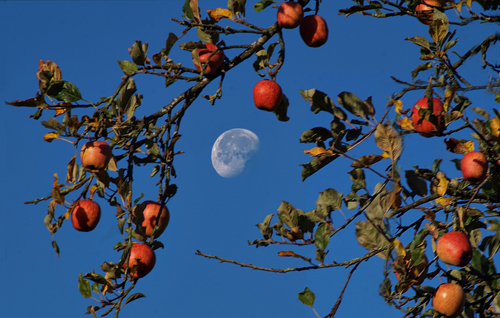
Homage to Isaac Newton
Image:Ian Morison
Newton wondered why, though apples fell to the ground, the Moon did not. His moment of genius was to realise that the Moon WAS falling. In a thought experiment in his book 'A Treatise of the System of the World' he envisaged a canon atop a mountain above the Earth's atmosphere firing its projectiles horizontally. As the muzzle velocity is increased, it will fall to ground at greater distances from the mountain. However, when the muzzle velocity reaches 7,300 m/sec, the projectile falls at the same rate as the 'falling' surface of the Earth, so remains in orbit at the same height above Earth.
Newton was able to calulate the value of the gravitational constant 'g' at the height of the Moon and it was 1/3,600 that on the Earth's surface. He knew that the Moon was 60 Earth radii from its centre so the value of g had fallen by the distance from the centre of the Earth squared. Before he could publish his theory of gravity, he had to prove that the gravitational effect of the Earth's mass was the same as if all the mass were concentrated at a point in its centre and was able to show that this was true by using 'fluxions' his development what is now called calculus.
He was able to derive Kepler's 'Third Law of Planetary Motion' from his equation and so knew that his law was valid throughout the solar system. He thus felt justified is calling it 'The Universal Law of Gravitation'.
An article 'Homage to Newton, describing how this image was created can be found in the digest whose link is above.
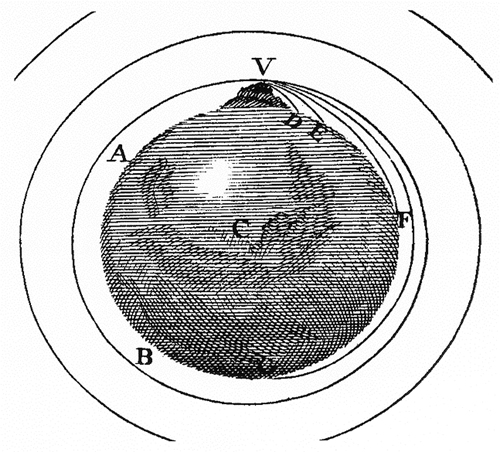
Newton's Mountain
Highlights of the Month
December 13th onwards - late evening: Comet 46P/Wirtanen could be visible to the unaided eye.
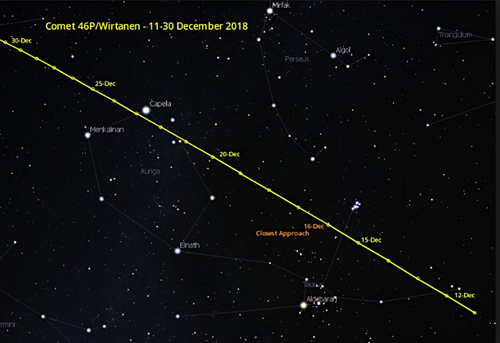
Track of 46P/Wirtanen.
Looking southeast late evening one should, if clear, be able to spot a naked eye comet. Its location is shown on the chart. Let's hope it is clear on the night of the 15th/16th when it passes between th Hyades and Pleiades cluster in Taurus. It lies very close to Capella in Auriga on the 23rd, but, sadly that night is close to Full Moon. It is hoped that it will reach a magnitude of +3.
December 3rd - before dawn: Venus below a very thin crescent Moon.
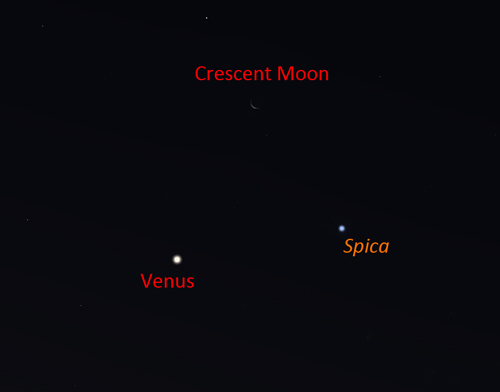
Venus below a thin crescent Moon.
Image: Stellarium/IM
Looking southeast before dawn one should, if clear, be able to easily spot brilliant Venus lying below a very thin crescent Moon. Spica is over to the right of Venus making a nice photo opportunity.
December 7th - 1 hour after sunset: A very close conjunction of Mars and Neptune
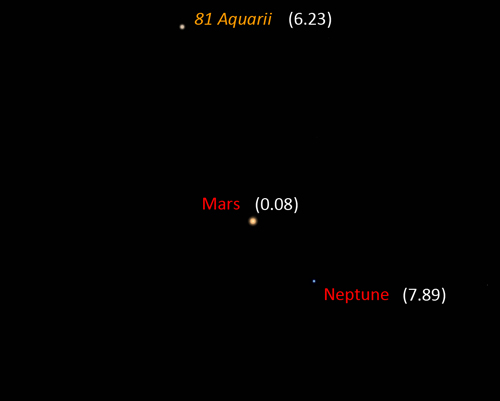
Mars and Neptune together
Image: Stellarium/IM
Looking south after sunset one should, if clear, be able to easily spot Mars. But when it gets fully dark, with binoculars or a small telescope, Neptune should appear just down to its lower right. A great opportunity to find Neptune - lets hope its clear!
December 14th - after sunset: Mars will lie 4 degrees above the First Quarter Moon
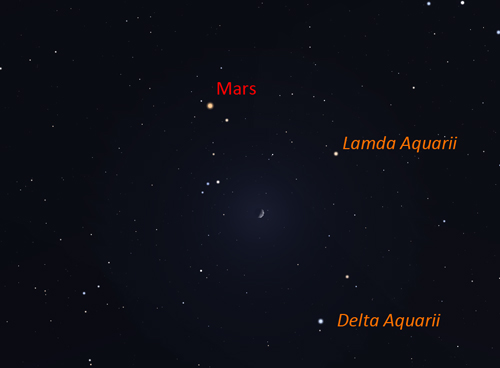
Mars above the Moon
Image: Stellarium/IM
Looking south after sunset one should, if clear, be able to easily spot Mars lying about 4 degrees above the First Quarter Moon making a nice photo opportunity.
December 14th and 15th after midnight: the Geminid Meteor Shower.
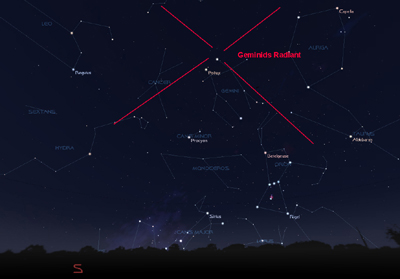
The Geminid Meteor shower
Image:Stellarium/IM
The Geminids
The early mornings of December 14th and 15th will give us the chance, if clear, of observing the peak of the Geminid meteor shower. The Moon is at First Quarter and will set around 11 pm so, when Gemini is highest in the sky, its light will not hinder our view. The Geminids can often produce near-fireballs and so the shower is well worth observing if its clear. An observing location well away from towns or cities will pay dividends. The relatively slow moving meteors arise from debris released from the asteroid 3200 Phaethon. This is unusual, as most meteor showers come from comets. The radiant - where the meteors appear to come from - is close to the bright star Castor in the constellation Gemini as shown on the chart. If it is clear it will be cold - so wrap up well, wear a woolly hat and have some hot drinks with you.
December 21st - just before dawn: Jupiter and Mercury together with Venus above
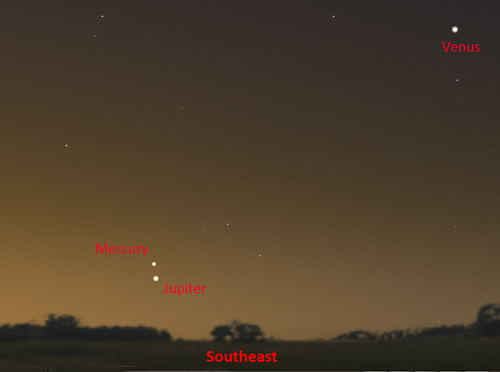
Mercury just above Jupiter
Image: Stellarium/IM
If clear just before dawn, and given a low horizon towards the east, one should be able to see Mercury lying a little above Jupiter making it appearance in a new apparition. Venus will be shining brightly up to their right. A nice photo opportunity.
December 22nd/23rd - late evenings: the Ursid Meteor Shower
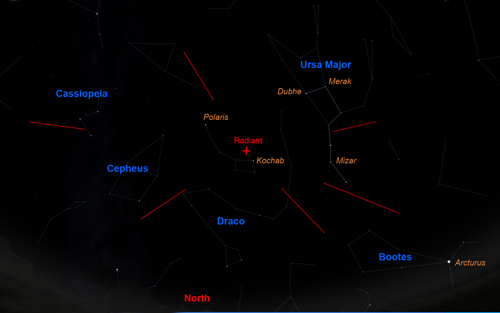
The Ursid meteor shower
Image: Stellarium/IM
The late evenings of the 22nd and 23rd of December are when the Ursid meteor shower will be at its best - though the peak rate of ~10-15 meteors per hour is not that great. Sadly, this year Full Moon is on the 21st, so its light will greatly hinder our view. The radiant lies close to the star Kochab in Ursa Minor (hence their name), so look northwards at a high elevation. Occasionally, there can be a far higher rate so its worth having a look should it be clear.
December 16th (late night) and 17th: Two Great Lunar Craters
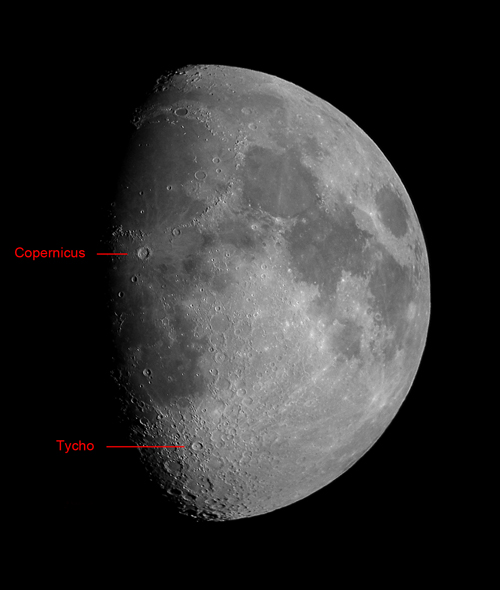
Tycho and Copernicus: Ian Morison
Two great Lunar Craters: Tycho and Copernicus
This is a great night to observe two of the greatest craters on the Moon, Tycho and Copernicus, as the terminator is nearby. Tycho is towards the bottom of Moon in a densely cratered area called the Southern Lunar Highlands. It is a relatively young crater which is about 108 million years old. It is interesting in that it is thought to have been formed by the impact of one of the remnents of an asteroid that gave rise to the asteroid Baptistina. Another asteroid originating from the same breakup may well have caused the Chicxulub crater 65 million years ago. It has a diameter of 85 km and is nearly 5 km deep. At full Moon - seen in the image below - the rays of material that were ejected when it was formed can be see arcing across the surface. Copernicus is about 800 million years old and lies in the eastern Oceanus Procellarum beyond the end of the Apennine Mountains. It is 93 km wide and nearly 4 km deep and is a clasic "terraced" crater. Both can be seen with binoculars.
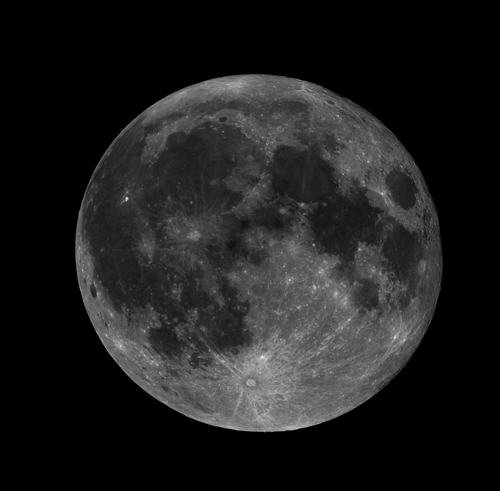
Full Moon showing Tycho's rays: Ian Morison
A Messier Object imaged with the Faulkes Telescope: Messier 1 - The Crab Nebula
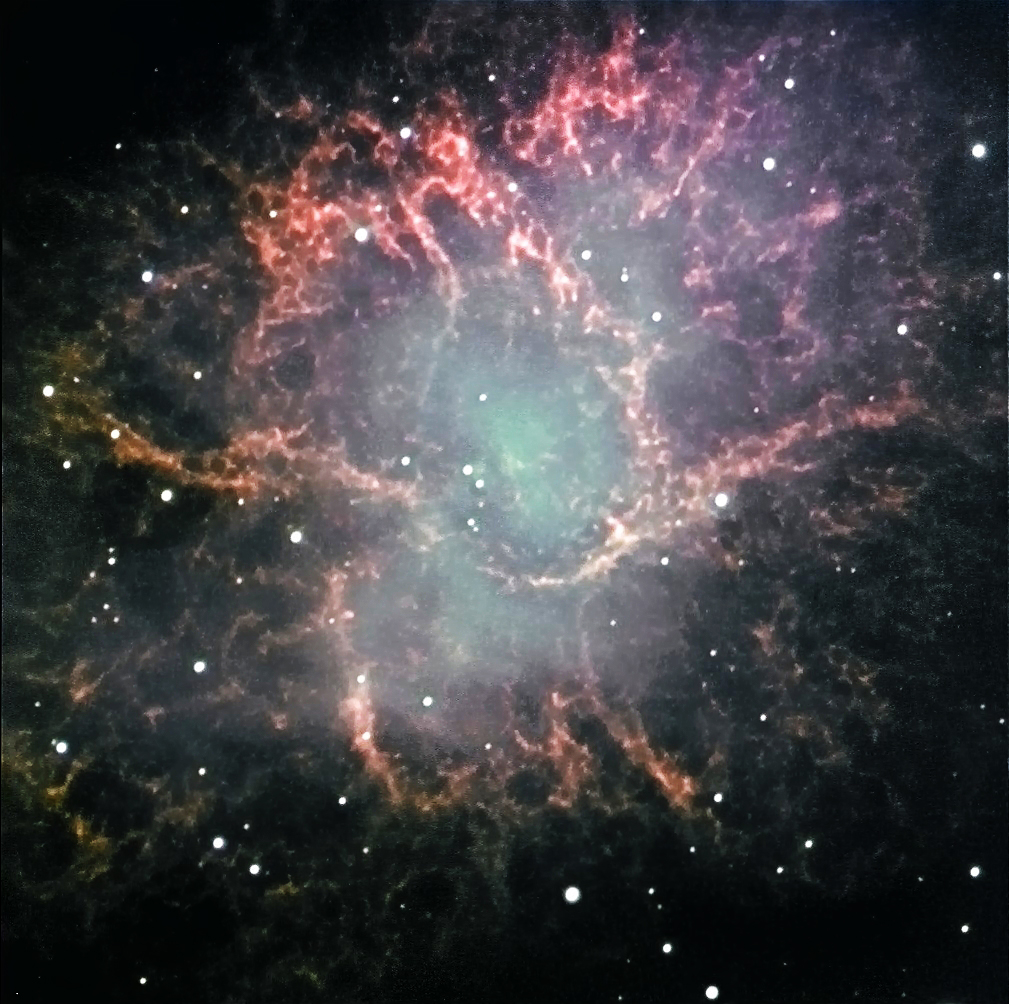
The Crab Nebula, M1
Image:Nik Szymanik
Faulkes Telescope North.
The Crab Nebula, M16, imaged by Nik Szymanek.
This image was taken using the Faulkes Telescope North by Nik Szymanek - one of the UK's leading astro-photograpers. The Crab nebula - the first entry in Charles Messier's catalogue - is the remnant of a supernovae that was seen to explode in the year 1054. It is visible as the lower right of the pair of stars at the centre of the nebula and is a "neutron star" just 30km across but weighing more than our Sun! Under the intense pressure of gravity, the protons and electrons fused to form neutrons and the compact object became stable as gravity was opposed by "neutron degeneracy pressure" - a quantum mechanical force. It is now spinning just under 30 times a second and emitting two opposed beams of light and radio waves which pass across our location in space. We thus detect very regular pulses and so objects like this are called pulsars. At 8.4 magnitudes it is easily seen in a small telescopes under dark transparent skies appearing as a smudge of light which is a little underwhelming to see!
Learn more about the Faulkes Telescopes and how schools can use them: Faulkes Telescope"
Observe the International Space Station

The International Space Station and Jules Verne passing behind the Lovell Telescope on April 1st 2008.
Image by Andrew Greenwood
Use the link below to find when the space station will be visible in the next few days. In general, the space station can be seen either in the hour or so before dawn or the hour or so after sunset - this is because it is dark and yet the Sun is not too far below the horizon so that it can light up the space station. As the orbit only just gets up the the latitude of the UK it will usually be seen to the south, and is only visible for a minute or so at each sighting. Note that as it is in low-earth orbit the sighting details vary quite considerably across the UK. The NASA website linked to below gives details for several cities in the UK. (Across the world too for foreign visitors to this web page.)
Note: I observed the ISS three times recently and was amazed as to how bright it has become.
Find details of sighting possibilities from your location from: Location Index
See where the space station is now: Current Position
The Moon
 The Moon at 3rd Quarter. Image, by Ian Morison, taken with a 150mm Maksutov-Newtonian and Canon G7.
The Moon at 3rd Quarter. Image, by Ian Morison, taken with a 150mm Maksutov-Newtonian and Canon G7.
Just below the crator Plato seen near the top of the image is the mountain "Mons Piton". It casts a long shadow across the maria from which one can calculate its height - about 6800ft or 2250m.
| new moon |
first quarter |
full moon |
last quarter |
`
| December 6th |
December 14th |
December 21st |
December 28th |
Some Lunar Images by Ian Morison, Jodrell Bank Observatory: Lunar Images
A World Record Lunar Image
 The 9 day old Moon.
The 9 day old Moon.
To mark International Year of Astronomy, a team of British astronomers have made the largest lunar image in history and gained a place in the Guinness Book of Records! The whole image comprises 87.4 megapixels with a Moon diameter of 9,550 pixels. The resolution of ~0.4 arc seconds allows details as small as 1km across to be discerned! The superb quality of the image is shown by the detail below of Plato and the Alpine Valley. Craterlets are seen on the floor of Plato and the rille along the centre of the Alpine valley is clearly visible. The image quality is staggering! The team of Damian Peach, Pete lawrence, Dave Tyler, Bruce Kingsley, Nick Smith, Nick Howes, Trevor Little, David Mason, Mark and Lee Irvine with technical support from Ninian Boyle captured the video sequences from which 288 individual mozaic panes were produced. These were then stitched together to form the lunar image.
 Plato and the Alpine Valley.
Plato and the Alpine Valley.
Please follow the link to the Lunar World Record website and it would be really great if you could donate to Sir Patrick Moore's chosen charity to either download a full resolution image or purchase a print.
The 8 day old Moon
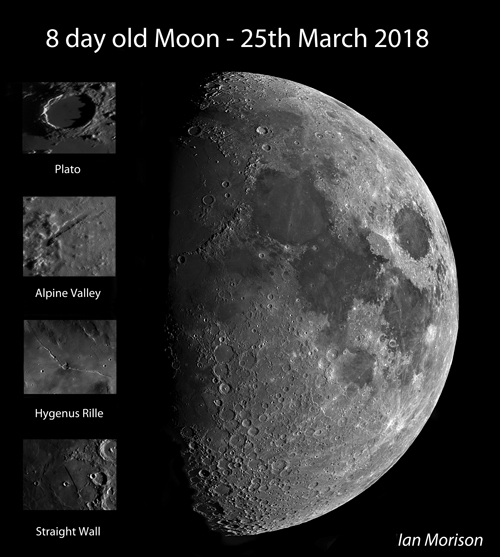 The 8 day old Moon imaged by Ian Morison.
The 8 day old Moon imaged by Ian Morison.
This image was taken by the author on a night in March 2018 when the Moon was at an elevation of ~52 degrees and the seeing was excellent. This enabled the resolution of the image to be largely determined by the resolution of the 200 mm aperture telescope and the 3.75 micron pixel size of the Point Grey Chameleon 1.3 megapixel video camera. The use of a near infrared filter allowed imaging to take place before it was dark and also reduced the effects of atmospheric turbulence. The 'Drizzle' technique developed by the Hubble Space Telescope Institute (HSTI) was used to reduce the effective size of the camera's pixels to allow the image to be well sampled. Around 100 gigabytes of data, acquired over a 2 hour period, was processed to produce images of 54 overlapping areas of the Moon which were then combined to give the full lunar disk in the free 'stitching' program Microsoft ICE. A further HSTI development called 'deconvolution sharpening' was then applied to the image. The Moon's disk is ~6,900 pixels in height and has a resolution of 0.6 to 0.7 arc seconds. Interestingly, as seen in the inset image, the rille lying along the centre of the Alpine Valley is just discernable and this is only ~0.5 km wide! [Due to size limitations the large image is 2/3 full size.]
The Planets

A montage of the Solar System. JPL / Nasa
Jupiter

A Cassini image of Jupiter . Nasa
Jupiter passed behind the Sun on November 26th and will appear low in the eastern pre-dawn sky around the 12th of the month. It will have a magnitude of ~-1.8 and a disk ~32 arc seconds across. Not a good month to observe it due to its low elevation, but do see the 'highlight' above.
Saturn

The planet Saturn. Cassini - Nasa
Saturn might just be glimpsed in the first few days of December very low in the southwest around 16:45, but soon disappears into the Sun's glare as it moves towards superior conjunction on January 2nd. It will have a disk of ~15 arc seconds and a magnitude of +0.5.
Mercury

Messenger image of Mercury Nasa
Mercury passed between us and the Sun (inferior conjunction) on the 27th of November but appears in the pre-dawn sky around the 6th of the month. It will then have a magnitude of +0.5 which increases to magnitude 0.0 by the 8th. Mercury reaches its greatest elongation (west) of the Sun on the 16th, then 21 degrees away, and rises over an hour and a half before the Sun when it is ~60% lit. As the morning ecliptic is at a steep angle to the horizon at this time of the year, this is an excellent apparition. Do not miss (when hopefully clear) its conjunction with Jupiter as described above.
Mars

A Hubble Space Telescope image of Mars.
Jim Bell et al. AURA / STScI / Nasa
Mars, though fading from magnitude -0.0 to +0.4 during the month remains prominent in the southern sky as it starts the month in Aquariusat an elevation of 27 degrees. It will lie due south around 6 pm. It moves eastwards into Pices on the 21st; slightly higher in elevation at ~32 degrees when due south around 5:30 pm. Its angular size falls from 9.3 arc seconds to 7.5 arc seconds during the month so it will become harder to spot any details, such as Syrtis Major, on its salmon-pink surface.
Venus

Venus showing some cloud structure
Venus begins December at an elevation of ~32 degrees and a dazzling magnitude of -4.9. Its angular size reduces from 40.7 to 26.6 arc seconds during the month as it moves away from the Earth but, at the same time, the precentage illuminated disk (its phase) increases from 26% to 47% - which is why the brightness only reduces from -4.9 to -4.6 magnitudes. It will reach greatest elongation from the Sun on January 6th,

Radar image showing surface features
See highlight above.
The Stars
The Late Evening December Sky
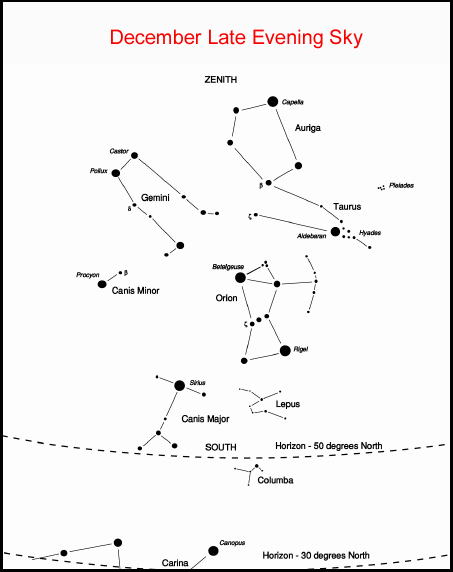 The December Sky in the south - late evening
The December Sky in the south - late evening
This maps shows the constellations seen towards the south in early and late evening. Setting towards the west in early evening is the beautiful region of the Milky Way containing both Cygnus and Lyra. Below is Aquilla. The three bright stars Deneb (in Cygnus), Vega (in Lyra) and Altair (in Aquila) make up the "Summer Triangle". East of Cygnus is the great square of Pegasus - adjacent to Andromeda in which lies M31, the Andromeda Nebula. To the north lies "w" shaped Cassiopeia and Perseus. The lower map shoesthe constellation Taurus, with its two lovely clusters, the Hyades and the Pleaides, and is also described in more detail below. as the evening draws on, Orion, the Hunter, follows Taurus into the eastern sky with the constellations Auriga, above, and Gemini, to the upper left. Later Sirius, in Canis Major will be seen to the lower left of Orion. Due to its brightness and scintillations caused by the atmosphere it often appears as a rainbow of colours flashing in the sky.
The constellations Pegasus and Andromeda
 Pegasus and Andromeda
Pegasus and Andromeda
Pegasus
The Square of Pegasus is in the south during the evening and forms the body of the winged horse. The square is marked by 4 stars of 2nd and 3rd magnitude, with the top left hand one actually forming part of the constellation Andromeda. The sides of the square are almost 15 degrees across, about the width of a clentched fist, but it contains few stars visibe to the naked eye. If you can see 5 then you know that the sky is both dark and transparent! Three stars drop down to the right of the bottom right hand corner of the square marked by Alpha Pegasi, Markab. A brighter star Epsilon Pegasi is then a little up to the right, at 2nd magnitude the brightest star in this part of the sky. A little further up and to the right is the Globular Cluster M15. It is just too faint to be seen with the naked eye, but binoculars show it clearly as a fuzzy patch of light just to the right of a 6th magnitude star.
Andromeda
The stars of Andromeda arc up and to the left of the top left star of the square, Sirra or Alpha Andromedae. The most dramatic object in this constellation is M31, the Andromeda Nebula. It is a great spiral galaxy, similar to, but somewhat larger than, our galaxy and lies about 2.5 million light years from us. It can be seen with the naked eye as a faint elliptical glow as long as the sky is reasonably clear and dark. Move up and to the left two stars from Sirra, these are Pi amd Mu Andromedae. Then move your view through a rightangle to the right of Mu by about one field of view of a pair of binoculars and you should be able to see it easily. M31 contains about twice as many stars as our own galaxy, the Milky Way, and together they are the two largest members of our own Local Group of about 3 dozen galaxies.
 M31 - The Andromeda Nebula
M31 - The Andromeda Nebula
M33 in Triangulum
If, using something like 8 by 40 binoculars, you have seen M31 as described above, it might well be worth searching for M33 in Triangulum. Triangulum is
the small faint constellation just below Andromeda. Start on M31, drop down to Mu Andromedae and keep on going in the same direction by the same distance as you have moved from M31 to Mu Andromedae. Under excellent seeing conditions (ie., very dark and clear skies) you should be able to see what looks like a little piece of tissue paper stuck on the sky or a faint cloud. It appears to have uniform brightness and shows no structure. The shape is irregular in outline - by no means oval in shape and covers an area about twice the size of the Moon. It is said that it is just visible to the unaided eye, so it the most distant object in the Universe that the eye can see. The distance is now thought to be 3.0 Million light years - just greater than that of M31.
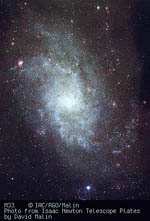 M33 in triangulum - David Malin
M33 in triangulum - David Malin
The constellation Taurus
 Taurus
Taurus
Taurus is one of the most beautiful constellations and you can almost imagine the Bull charging down to the left towards Orion. His face is delineated by the "V" shaped cluster of stars called the Hyades, his eye is the red giant star Aldebaran and the tips of his horns are shown by the stars beta and zeta Tauri. Although alpha Tauri, Aldebaran, appears to lie amongst the stars of the Hyades cluster it is, in fact, less than half their distance lying 68 light years away from us. It is around 40 times the diameter of our Sun and 100 times as bright.
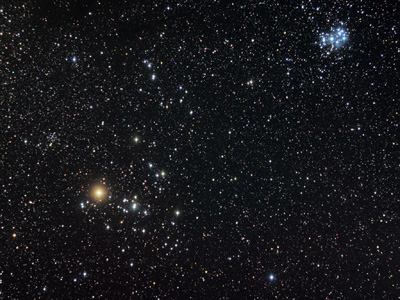 The Hyiades and Pleiades. Copyright: Alson Wong.
The Hyiades and Pleiades. Copyright: Alson Wong.
More beautiful images by Alson Wong : Astrophotography by Alson Wong
To the upper right of Taurus lies the open cluster, M45, the Pleiades. Often called the Seven Sisters, it is one of the brightest and closest open clusters. The Pleiades cluster lies at a distance of 400 light years and contains over 3000 stars. The cluster, which is about 13 light years across, is moving towards the star Betelgeuse in Orion. Surrounding the brightest stars are seen blue reflection nebulae caused by reflected light from many small carbon grains. These relfection nebulae look blue as the dust grains scatter blue light more efficiently than red. The grains form part of a molecular cloud through which the cluster is currently passing. (Or, to be more precise, did 400 years ago!)
 VLT image of the Crab Nebula
VLT image of the Crab Nebula
Close to the tip of the left hand horn lies the Crab Nebula, also called M1 as it is the first entry of Charles Messier's catalogue of nebulous objects. Lying 6500 light years from the Sun, it is the remains of a giant star that was seen to explode as a supernova in the year 1056. It may just be glimpsed with binoculars on a very clear dark night and a telescope will show it as a misty blur of light.
 Lord Rosse's drawing of M1
Lord Rosse's drawing of M1
Its name "The Crab Nebula" was given to it by the Third Earl of Rosse who observed it with the 72 inch reflector at Birr Castle in County Offaly in central Ireland. As shown in the drawing above, it appeared to him rather lile a spider crab. The 72 inch was the world's largest telelescope for many years. At the heart of the Crab Nebula is a neutron star, the result of the collapse of the original star's core. Although only around 20 km in diameter it weighs more than our Sun and is spinning 30 times a second. Its rotating magnetic field generate beams of light and radio waves which sweep across the sky. As a result, a radio telescope will pick up very regular pulses of radiation and the object is thus also known a Pulsar. Its pulses are monitored each day at Jodrell Bank with a 13m radio telescope.
The constellation Orion
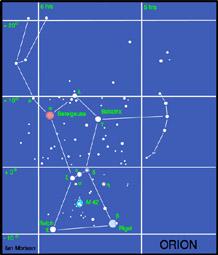 Orion
Orion
Orion, perhaps the most beautiful of constellations, will be seen in the south at around 11 - 12 pm during January. Orion is the hunter holding up a club and shield against the charge of Taurus, the Bull up and to his right. Alpha Orionis, or Betelgeuse, is a read supergiant star varying in size between three and four hundred times that of our Sun. The result is that its brightness varies somewhat. Beta Orionis, or Rigel, is a blue supergiant which, at around 1000 light years distance is about twice as far away as Betelgeuse. It has a 7th magnitude companion. The three stars of Orion's belt lie at a distance of around 1500 light years. Just below the lower left hand star lies a strip of nebulosity against which can be seen a pillar of dust in the shape of the chess-board knight. It is thus called the Horsehead Nebula. It shows up very well photographically but is exceedingly difficult to see visually - even with relativly large telescope.
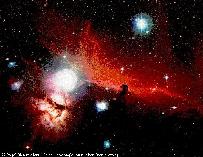 The Horsehead Nebula: Anglo Australian Observatory
The Horsehead Nebula: Anglo Australian Observatory
Beneath the central star of the belt lies Orion's sword containing one of the most beautiful sights in the heavens - The Orion Nebula. It is a region of star formation and the reddish colour seen in photographs comes from Hydrogen excited by ultraviolet emitted from the very hot young stars that make up the Trapesium which is at its heart. The nebula, cradling the trapesium stars, is a beautiful sight in binoculars or, better still, a telescope. To the eye it appears greenish, not red, as the eye is much more sensitive to the green light emitted by ionized oxygen than the reddish glow from the hydrogen atoms.
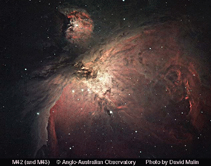 The Orion Nebula: David Malin
The Orion Nebula: David Malin






































